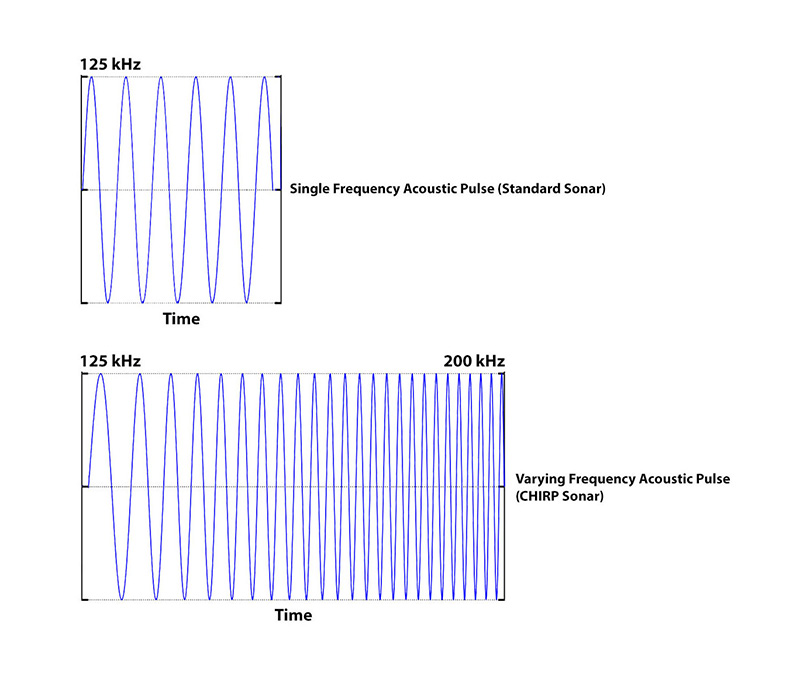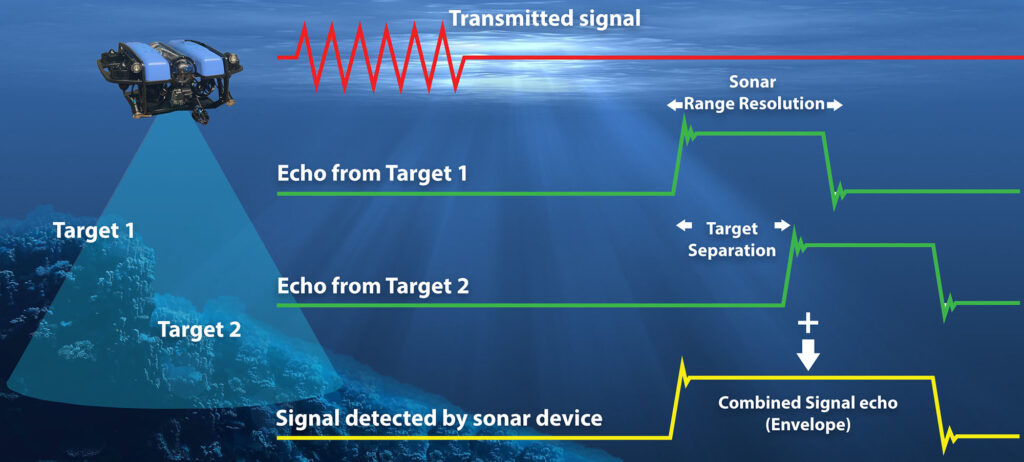CHIRP stands for “Compressed High-Intensity Radar Pulse.” Instead of sending a single frequency like standard sonars, CHIRP pulses are a continuous sweep of frequencies extending from low to high (or high to low).

CHIRP sonar uses signal processing techniques to precisely identify the center of the received pulse. The signal processing improves both range resolution and signal-to-noise-ratio (SNR), allowing for a lower-power transmitter.
Why is CHIRP useful?
To explain the advantages of using CHIRP acoustic techniques, we must first understand the limitations of using conventional (monotonic) sonar techniques to acquire sonar imaging. A monotone acoustic pulse consists of a single carrier frequency modulated by its amplitude (typically, modulated from off to on to off).
The figure below shows the correlation between the sonar transmitted signal and the receiver circuitry produced output. The receiver will not decode every cycle of the broadcasted pulse. Instead, it generates an envelope of its overall amplitude.

The pulse duration determines the ability of the acoustic system to resolve targets. The shorter the pulse length, the higher the resolution and ability to resolve separate targets. However, this approach has its drawbacks.
To place sufficient acoustic energy into the water for proper target identification and over a wide variety of ranges, the transmission pulse length has to be relatively long.
Due to the speed of sound through water (“VOS” – typically around 1500 meters/sec), each pulse occupies an equivalent “distance” related to its pulse duration – this is referred to as “range resolution,” and can be resolved by the following equation.
Range resolution = (pulse-length x velocity of sound) / 2
For instance, in a conventional sonar system at a moderate range, a typical pulse length is 100 microseconds (µs) while the velocity of sound (VOS) in water is 1500 m/s (typically). Consequently, the range resolution would be 75 mm.

The formula adequately predicts the ability to resolve separate targets. Using the example above, if the two targets are less than 75 mm apart, it will not be possible to distinguish them as two different items. The result is that the sonar system will display a single large target, rather than two smaller targets.
How does CHIRP Operates?
Unlike standard monotonic sonars, a CHIRP pulse swept through continuously through the pulse time.
For example. A CHIRP sonar may send a pulse starting at 125KHz and ending at 150KHz. The difference separating these two frequencies is known as the “bandwidth” of the transmission. Typically, the center frequency of the broadcast is used to identify the sonar (in this case, it would be a 137.5KHz sonar).

By continuously shifting its frequency over time, the CHIRP signal can be perceived as having a unique acoustic signature. If two pulses overlap due to targets being closer than the range resolution, the CHIRP “frequency versus time information” can be used to discern them as separate images.
CHIRP sonar looks for transmitted CHIRPS echoed back from targets, with the receiver producing a sharp ‘spike’ when a suitable match is found. A monotonic sonar can only generate an output the same duration as its transmit pulse.
With CHIRP, the crucial factor for ascertaining range resolution is not the pulse interval, but rather the CHIRP bandwidth. The following formula can find the range resolution.
Range resolution = Velocity Of Sound /(Bandwidth x 2)
As an example, a chirp sonar with a bandwidth of 50kHZ would have a range resolution of 15mm, assuming a VOS of 1,500 meters/sec. Such a result would provide a theoretical five-fold improvement over the fixed frequency (monotonic) sonar previously discussed.

On the illustration shown above, the two acoustic echoes overlap. However, these CHIRP signals do not merge into a single acoustic return since their frequencies differ from each other at the overlapping points. On a CHIRP sonar environment, the sonar discerns and renders the two targets separately. With CHIRP technology, longer transmissions are feasible, allowing us to see targets further away and without loss in resolution.